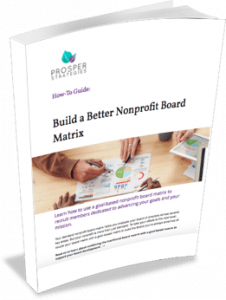Every nonprofit board is dynamic and ever-changing, and every board member is different, so knowing when and how to include members in important decision-making processes can be a challenge. However, it’s important to determine what works best for your nonprofit board and come up with engagement strategies for everyone involved.
In fact, we recently worked with an organization that was developing new key messages. As they were going through the process, they had the revelation that crafting messaging was only part of it — ensuring the new messages were used across the organization, including by board members, felt like another challenge altogether.
As we know from experience, having nonprofit board members involved from conception to launch to implementation is critical to project success. Here, we’ll break down some recommendations for when and how to involve board members in big decisions surrounding things like strategic planning and rebranding.
Solicit Nonprofit Board Member Input Throughout
The first and most important thing to remember about board involvement in any process is to solicit feedback throughout. For example, if your organization is drafting a new vision and mission statement, start the process by reviewing the current vision and mission statements with nonprofit board members to understand what they like and dislike.
Then, clearly lay out your approach, plan and timeline and provide them the opportunity to give input on those items. They may have suggestions for how you can create efficiencies or where they would like to be involved. Sticking with the new vision and mission example, let them know that you’re planning to do several vision and mission workshops over the course of a month with staff and clients. Once you do, you’ll come back to them to share the working statements for their feedback before finalizing and putting them to a vote. Outlining your process allows you to get input, but also creates certainty for everyone involved.
A good rule of thumb is to involve your board at the beginning of a process, a time or two in the middle and then again before finalizing. As rollout and implementation phases are underway, continue to keep them apprised of progress, challenges and opportunities you’re experiencing.
Utilize Nonprofit Board Committees
For larger projects where you anticipate needing more board feedback, consider utilizing a board committee for support. This is typical in larger processes, like the development of your nonprofit’s strategic plan. Rather than involving the entire nonprofit board at every phase, a committee of board members can be tasked with being more directly involved with planning, participating in workshops, priority development and the like. Then, this committee will also be responsible for sharing progress back with fellow nonprofit board members.
Leveraging committees is highly successful because while these folks serve as representatives for the larger board, they also become champions of the process and project.
Provide Multiple Ways for Nonprofit Board Members to Share Feedback
Some nonprofit board members like to roll up their sleeves, while others like to provide more consultative support, and this can vary by project type. If you’re working on growth projections, board members with finance experience might want to play a larger role, while if you’re building a new marketing plan, those with marketing and communications experience might want to be more heavily involved. This is why you always want to give board members multiple ways to be involved and give input. This can range from committee participation, as noted above, to more limited meeting participation at key strategic checkpoints, to opportunities to share feedback on their own time through online surveys, polls or email correspondence. Providing multiple ways for nonprofit board members to give feedback ensures people can provide input in ways that most align with their schedules, expertise and preferred way to share, and it also increases the likelihood of involvement across the board.
We always start projects by mapping out the entire timeline and then discuss when and how nonprofit board members need to be involved. This ensures we get the diverse perspectives needed for success in planning and implementation.
It’s time to build a better nonprofit board using a goal-based board matrix.
 While a standard nonprofit board matrix helps you evaluate your board of directors across several key areas, your nonprofit is more than just standard. To take your efforts to the next level, couple your board matrix with a goal-based matrix to build the board you’ve always dreamed of.
While a standard nonprofit board matrix helps you evaluate your board of directors across several key areas, your nonprofit is more than just standard. To take your efforts to the next level, couple your board matrix with a goal-based matrix to build the board you’ve always dreamed of.
